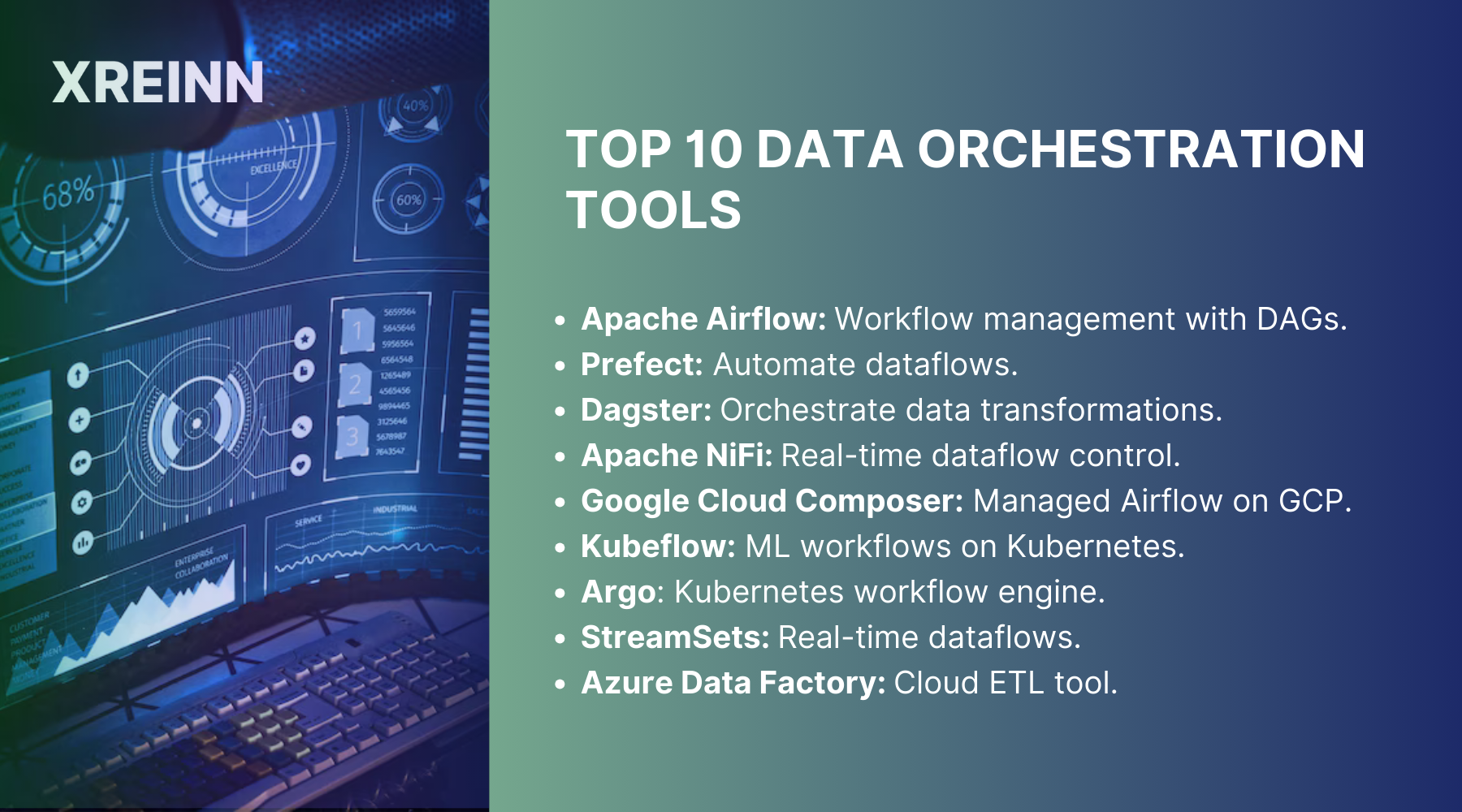Data Integration
Top 10 Data Orchestration Tools You Need to Know
Jul 24, 2024
The mess of poorly managed data can lead to inefficiencies, missed opportunities, and expensive mistakes. Without effective data orchestration tools, managing, processing, and analyzing large datasets is almost impossible, leading to fragmented data and inconsistent insights.
Data orchestration tools come to the rescue in this data-driven age. These tools automate, coordinate, and optimize your data workflows, ensuring smooth integration, accessibility, and reliability.
In this overview, you’ll learn the top 10 data orchestration tools. Each tool offers unique features to simplify your data management processes and help you stay ahead.
What is Data Orchestration?
Data orchestration is the automated process of collecting, organizing, and managing data from various sources to ensure it moves smoothly and accurately through the entire data pipeline. It involves coordinating different data workflows, tools, and processes to make sure data is accessible, reliable, and ready for analysis.
In simpler terms, data orchestration is like a conductor leading an orchestra, ensuring that each instrument (or data source) plays its part at the right time and in harmony with others. This process helps businesses and organizations transform raw data into valuable insights efficiently and effectively. Without data orchestration, managing data can become chaotic, leading to delays, errors, and lost opportunities.
Top 10 Data Orchestration Tools

1. Apache Airflow
Apache Airflow is an open-source platform for authoring, scheduling, and monitoring workflows using Directed Acyclic Graphs (DAGs).
How it works: Airflow allows you to define workflows as code, making it easy to version, share, and collaborate on your workflows. It supports dynamic pipeline generation and extensive customization through Python scripts, enabling you to manage complex workflows effectively.
2. Prefect
Prefectis a dataflow automation tool designed for simplicity and scalability, emphasizing ease of use and flexibility.
How it works: Prefect uses "Tasks" and "Flows" to define and orchestrate data workflows. Tasks represent the smallest units of work, while flows are orchestrations of tasks. Prefect provides strong error handling, state management, and retries, allowing you to build strong data pipelines that handle complex dependencies effortlessly.
3. Dagster
Dagster focuses on the orchestration of data assets and their transformations over time, offering a fresh perspective on data workflows.
How it works: Dagster enables you to define data pipelines using a combination of code and configuration, improving flexibility and reuse. Its integrated development environment, Dagit, provides an interactive and visual interface for designing, debugging, and monitoring pipelines, making it easier to manage complex workflows.
4. Apache NiFi
Apache NiFi is a data logistics platform that supports powerful and scalable directed graphs for data routing, transformation, and system mediation.
How it works: NiFi offers a web-based user interface for designing and monitoring data flows, supporting real-time control, feedback, and tracking. It is best in handling distinct data formats and sources, making it ideal for complex data integration tasks.
5. Google Cloud Composer
is a managed Apache Airflow service that simplifies workflow creation, scheduling, and monitoring on the Google Cloud Platform.
How it works: Cloud Composer provides all the benefits of Airflow without the need to manage the underlying infrastructure. It integrates seamlessly with other GCP services, making it an ideal choice for orchestrating data workflows within the Google Cloud ecosystem
6. Kubeflow
Kubeflow is an open-source toolkit for machine learning, designed to orchestrate end-to-end ML workflows on Kubernetes.
How it works: Kubeflow provides tools for developing, deploying, and managing scalable ML models. Kubeflow Pipelines allow you to define and share reusable components and workflows, ensuring your ML models are reproducible and scalable across different environments.
7. Argo
Argo is a Kubernetes-native workflow engine that supports both DAGs and step-based workflows for containerized environments.
How it works: Argo uses Kubernetes for scheduling, scaling, and managing workflows. Its simplicity and scalability make it an excellent choice for teams already using Kubernetes. With Argo Workflows, you can orchestrate jobs, handle dependencies, and ensure strong execution across your Kubernetes clusters.
8. StreamSets
StreamSetsis a data operations platform designed to manage dataflows in real time, providing a visual interface for building and monitoring pipelines.
How it works: StreamSets supports extensive integrations with various data sources and destinations, offering DataOps capabilities for continuous monitoring and optimization of dataflows. This ensures high-quality and timely data delivery across complex data environments.
9. Google Cloud Composer
is a managed Apache Airflow service that simplifies workflow creation, scheduling, and monitoring on the Google Cloud Platform.
How it works: Cloud Composer provides all the benefits of Airflow without the need to manage the underlying infrastructure. It integrates seamlessly with other GCP services, making it an ideal choice for orchestrating data workflows within the Google Cloud ecosystem.
10. Azure Data Factory
Azure Data Factory is a cloud-based data integration service that enables the creation, scheduling, and orchestration of data workflows across various sources.
How it works: Azure Data Factory offers a rich set of built-in connectors and transformation activities, allowing you to build sophisticated ETL processes with minimal code. Its visual interface and strong monitoring capabilities make it a powerful tool for managing complex data workflows in the cloud.
Conclusion
Data orchestration tools can significantly improve your data management strategies. Each tool offers unique features customized to various workflow requirements, making it essential to choose the one that aligns with your specific needs. By using these tools, you can ensure your data processes are efficient, scalable, and strong, positioning your organization for success in the evolving data landscape. Stay informed and make strategic decisions to optimize your data orchestration in the year ahead.

Data Analytics
Jun 27, 2024Master key concepts in data analytics with practical tips to enhance decision-making and achieve success in your projects and professional growth

Data Analytics
Jul 01, 2024Learn the essential stages of the data analytics workflow to turn your data into valuable business insights and drive growth.

